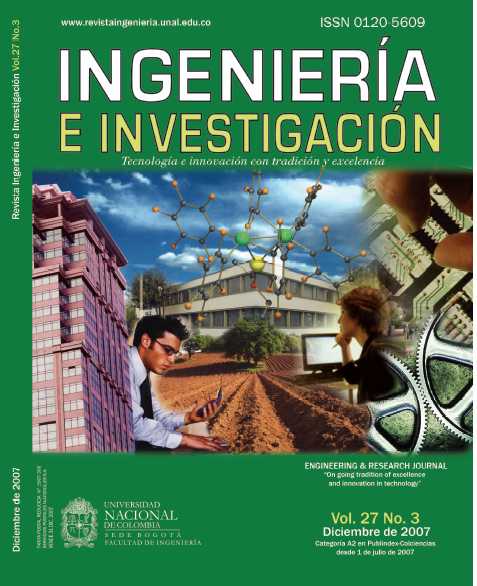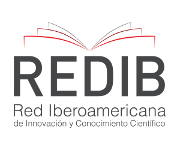Analysing polystyrene-modified asphalt and its incidence in a heat-dense asphalt mixture
Análisis de un asfalto modificado con icopor y su incidencia en una mezcla asfáltica densa en caliente
DOI:
https://doi.org/10.15446/ing.investig.v27n3.14840Keywords:
modified asphalt, asphalt, polystyrene, pavement, bituminous mixture fatigue (en)asfalto modificado, asfalto, poliestireno, pavimentos, fatiga de mezclas bituminosas (es)
Downloads
This article presents some results obtained with an MDC-2 asphalt/polystyrene-modified asphalt mixture as a result of crushing waste glass. The stone, asphalt and polystyrene materials’ were characterised for drawing up the design. The Marshal method was used for obtaining the best asphalt-stone-polystyrene percentages. The Superpave method was used for analysing the asphalt; the mixture’s dynamic behavior was analysed using a test involving 20°C and 30°C trapezoidal fatigue for 90x10-6, 150x10-6 and 220x10-6m deformation. The truck-wheel test was analysed for a 13-ton load, similar to that of the heaviest axle on a Transmilenio (articulated) bus. The dynamic module test was analysed for 15°C, 20°C and 30°C and 2.5, 5 and 10 Hz frequencies. Conventional asphalt mixture and modified asphalt results were contrasted, interesting behavior being observed regarding plastic deformation of the modified mixture in service.
En esta investigación se presentan los resultados obtenidos al elaborar una mezcla asfáltica MDC-2 con asfalto modificado con Icopor (poliestireno), resultado de la trituración de vasos desechables, con el ánimo de mejorar las propiedades mecánicas de las mezclas tipo rodadura y garantizar la durabilidad de las mismas bajo las solicitaciones impuestas en el periodo de diseño. Para el diseño se realizó la caracterización de los materiales pétreos, pertenecientes a una de las canteras de mayor utilización en la Sabana de Bogotá, del asfalto producido en Barrancabermeja, Santander, y del poliestireno obtenido de los desechos no biodegradables. El método empleado para la obtención de los porcentajes óptimos de asfalto-agregados-icopor, fue el Marshall. Se realizaron los siguientes ensayos: el estudio del asfalto teniendo en cuenta el envejecimiento, el comportamiento dinámico de la mezcla a partir de los ensayos de fatiga trapezoidal para 20°C y 30°C y para deformaciones de 90x10-6, 150x10-6 y 220x10-6m, ahuellamiento para una carga de 13 toneladas, similar a la del eje más pesado de un bus de Transmilenio, módulo dinámico para 15°C, 20°C y 30°C y para las frecuencias de 2.5, 5 y 10Hz. Los resultados obtenidos se contrastaron con los de una mezcla asfáltica convencional. Como conclusiones de esta investigación se destacan: la disminución en más de un 50% de la deformación plástica ocurrida por el paso de vehículos de 13 ton, de acuerdo con el modelo utilizado, el aumento de la estabilidad de la mezcla asfáltica conservando un menor peso y la posibilidad de inclusión de estos materiales de desecho que impactan el ambiente, pero contribuyen con la resistencia de un material como el concreto asfáltico, entre otros.
References
Arenas, H. L., Tecnología del cemento asfáltico., Fundación para Actividades de Investigación y Desarrollo, Cali, 2000.
Cuellar, A., Estudio comparativo de las leyes de fatiga de una mezcla cerrada 0/10 con y sin adiciones de icopor., Trabajo de Grado, Universidad Javeriana, Colombia, 2003.
Desarrollo de tecnologías para el uso de asfaltos y mezclas asfálticas modificadas., Caminos y Puentes Federales de Ingresos y Servicio Conexos, México, 1994.
Ecopetrol., Cartilla Práctica para el manejo de los Asfaltos Colombianos., Instituto Colombiano del Petróleo, 1999.
Figueroa, Reyes., Asfaltos modificados con Poliestireno. Universidad de La Salle, Bogotá, Colombia, 2005.
Gallego Medina, D. J., Mezclas bituminosas con betunes de alto contenido en caucho de neumáticos: una elección por las altas prestaciones., Universidad Politécnica De Madrid, Madrid, 2003.
Montejo Fonseca, A., Ingeniería de pavimentos para carreteras., Bogotá: Impreandes, 1998.
Oda., S. y Fernández J. J. L., Viabilidad Técnica de Usar Caucho de Neumático como Material de Pavimentación Asfáltica., Universidad Estadual de Maringá, Brasil, 2002.
Palit, S. K., Sudhakar Reddy, T, K. y Pandey, B.B., Laboratory Evaluation of Crumb Rubber Modified Asphalt Mixes., Journal of Material in Civil Engineering, January/ February, 2004. DOI: https://doi.org/10.1061/(ASCE)0899-1561(2004)16:1(45)
Reyes Ortiz, O., Mejoramiento de las propiedades mecánicas de una capa de asfalto con desperdicios plásticos., Bogotá, 1997.
Lunddtrom, R., Di Benedetto, H., Isacsson, U., Influence of Asphalt Mixture Stiffness on Fatigue Failure., Journal of Material in Civil Engineering, November/December, 2004. DOI: https://doi.org/10.1061/(ASCE)0899-1561(2004)16:6(516)
How to Cite
APA
ACM
ACS
ABNT
Chicago
Harvard
IEEE
MLA
Turabian
Vancouver
Download Citation
CrossRef Cited-by
1. Maria Fernanda Serrano-Guzmán, Diego Dario Pérez-Ruiz, Norma Cristina Solarte Vanegas. (2015). Use of Ash in Hot Dense Mixtures. Transportation Research Record: Journal of the Transportation Research Board, 2473(1), p.66. https://doi.org/10.3141/2473-08.
Dimensions
PlumX
Article abstract page views
Downloads
License
Copyright (c) 2007 Ana Sofía Figueroa Infante, Fredy Alberto Reyes Lizcano, Diana Hernández Barrera, Christian Jiménez, Natalia Bohórquez

This work is licensed under a Creative Commons Attribution 4.0 International License.
The authors or holders of the copyright for each article hereby confer exclusive, limited and free authorization on the Universidad Nacional de Colombia's journal Ingeniería e Investigación concerning the aforementioned article which, once it has been evaluated and approved, will be submitted for publication, in line with the following items:
1. The version which has been corrected according to the evaluators' suggestions will be remitted and it will be made clear whether the aforementioned article is an unedited document regarding which the rights to be authorized are held and total responsibility will be assumed by the authors for the content of the work being submitted to Ingeniería e Investigación, the Universidad Nacional de Colombia and third-parties;
2. The authorization conferred on the journal will come into force from the date on which it is included in the respective volume and issue of Ingeniería e Investigación in the Open Journal Systems and on the journal's main page (https://revistas.unal.edu.co/index.php/ingeinv), as well as in different databases and indices in which the publication is indexed;
3. The authors authorize the Universidad Nacional de Colombia's journal Ingeniería e Investigación to publish the document in whatever required format (printed, digital, electronic or whatsoever known or yet to be discovered form) and authorize Ingeniería e Investigación to include the work in any indices and/or search engines deemed necessary for promoting its diffusion;
4. The authors accept that such authorization is given free of charge and they, therefore, waive any right to receive remuneration from the publication, distribution, public communication and any use whatsoever referred to in the terms of this authorization.



























